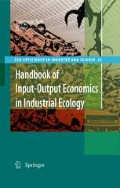In this paper we show how IO equations for sector outputs and prices are used as part of a larger policy analysis modeling system for energy and climate-related studies. The IO framework is particularly useful because it can accommodate the analysis of both price and direct program expenditure impacts. We briefly discuss the advantages of including non-price programs in any serious climate policy or sustainable energy strategy. Further, we contend that the impacts on the economy from a set of price and program expenditure polices can be seen by comparing constructed IO tables for a future year, such as 2030, with and without these polices. We present the All Modular Industry Growth Assessment (AMIGA) modeling system which has the capability to forecast future IO table values.
Access this chapter
Tax calculation will be finalised at checkout
Purchases are for personal use only
Preview
Unable to display preview. Download preview PDF.
References
Acemoglu, D. (2002). Directed technical change. Review of Economic Studies, 69(4), 781–809.
Armington, P. S. (1969). A theory of demand for products distinguished by place of production. International Monetary Fund Staff Papers, 16, 159–176.
Ballard, C., Fullerton, D., Shoven, J., & Whalley, J. (1985). A general equilibrium model for tax policy evaluation. Chicago: University of Chicago Press.
Baumol, W., & Oates, W. (1988). Theory of environmental policy. New York: Cambridge University Press.
BEA. (2005). Make and use annual input and output tables. Washington, DC: Bureau of Economic Analysis, U.S. Department of Commerce.
EIA. (2005). Annual energy outlook 2006 with projections to 2030. Washington, DC: Energy Information Administration, US Department of Energy.
EPA. (2003). Annual report. Protecting the environment together. Energy star and other voluntary programs. Washington, DC: US Environmental Protection Agency.
Greene, D., Duleep, K., & McManus, W. (2004). Future potential of hybrid and diesel powertrains in the US light-duty vehicle market. Washington, DC: US Department of Energy.
Hanson, D., & Laitner, J. A. S. (2004). An integrated analysis of policies that increase investments in advanced energy-efficient/low-carbon technologies. Energy Economics, 26(4), 739–755.
Hanson, D. A., & Laitner, J. A. (2006). Technology policy and world greenhouse gas emissions in the amiga modeling system. Cleveland, OH: Energy Journal.
Kemfert, C. (1998). Estimated substitution elasticities of a nested ces production function approach for Germany. Energy Economics, 20(3), 249–264.
Laitner, John A. “Skip”, and Donald A. Hanson. 2006. “Modeling Detailed Energy-Efficiency Technologies and Technology Policies within a CGE Framework.” Energy Journal Special Edition, Hybrid Modeling of Energy-Environment Policies: Reconciling Bottom-Up and Top-Down: 151–169.
Lancaster, K. (1971). Consumer demand: A new approach. New York: Columbia University Press.
Marano, J. (2005). Use of the mars petroleum refining model for energy and climate assessments. Paper presented at the INFORMS Operations Research Conference, San Francisco.
Press, W., & Vetterling, W. (1992). Numerical recipes in c: The art of scientific computing. New York: Cambridge University Press.
Ross, M., Thimmapuram, P., Fisher, R., & Maciorowski, W. (1993). Long-term industrial energy forecasting (lief) model (18-sector version). Argonne, IL: Argonne National Lab.
Steinmeyer, D. (1998). Trading capital for energy. Washington, DC: American Council for an Energy-Efficient Economy.
Varian, H., & Yohe, G. (1992). Microeconomic analysis (3rd ed.). New York: W.W. Norton.
Author information
Authors and Affiliations
Editor information
Editors and Affiliations
Rights and permissions
Copyright information
© 2009 Springer Science+Business Media B.V.
About this chapter
Cite this chapter
Hanson, D.A., Laitner, J.A.“. (2009). Input-Output Equations Embedded Within Climate and Energy Policy Analysis Models. In: Suh, S. (eds) Handbook of Input-Output Economics in Industrial Ecology. Eco-Efficiency in Industry and Science, vol 23. Springer, Dordrecht. https://doi.org/10.1007/978-1-4020-5737-3_21
Download citation
DOI: https://doi.org/10.1007/978-1-4020-5737-3_21
Publisher Name: Springer, Dordrecht
Print ISBN: 978-1-4020-4083-2
Online ISBN: 978-1-4020-5737-3
eBook Packages: Earth and Environmental ScienceEarth and Environmental Science (R0)

